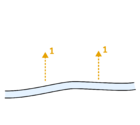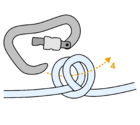Clove hitch: Difference between revisions
Appearance
Created the starting template, images are missing |
|||
| Line 17: | Line 17: | ||
=== Easy method === | === Easy method === | ||
This method is very robust and suitable for learning how to tie the hitch. | This method is very robust and suitable for learning how to tie the hitch. | ||
[[File: clove_1.png |140px]] | |||
[[File: clove_2.png |140px]] | |||
[[File: clove_3.png |140px]] | |||
[[File: clove_4.png |140px]] | |||
[[File: clove_5and6.png |140px]] | |||
[[File: clove_final_p6.png|84px]] | |||
=== One-hand method === | === One-hand method === | ||
Revision as of 05:19, 10 August 2025
| Clove hitch | |
|---|---|
| Other names | HMS, HMS knot, munter |
| Use(s) | Belaying, rescue techniques |
| Pros | Fast, simple, just HMS carabiner needed |
| Cons | Rope abrasion, rope tangling, no braking assist |
| Category | Hitch |
Clove hitch is an essential knot used in many occasions when semi-adjustable reliable knot is needed and thus finds its place in most of the knotting operations during climbing such as anchor building, offsetting belay station for the second climber, or self-attaching of the lead climber with a rope to the anchor point.
Quick overview
Tying
Easy method
This method is very robust and suitable for learning how to tie the hitch.



 File:Clove 5and6.png
File:Clove final p6.png
File:Clove 5and6.png
File:Clove final p6.png
One-hand method
Non-crucial, but handy once you have only one hand free.
Quick repositioning
One of the strongest points of the clove hitch is its quick repositioning.